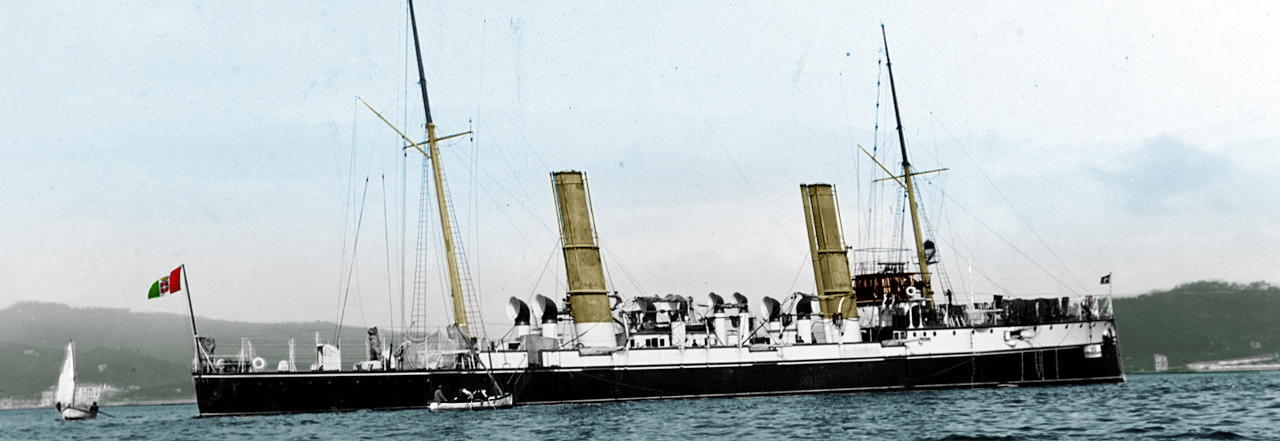
The last ‘Esploratori’
Agordat and Coatit were built at Castellamare in 1897. They had been designed by Nabor Soliani as protected scout cruisers, launched in 1899 and commissioned in 1900. They derived also from Italian Torpedo Cruisers and became a first modern attempt as creating a scout cruiser or “esploratori”. Alas, they were lightly armed, proved too slow and too short ranged to be useful as such, and apart the Italo-Turkish War of 1911–12, they saw little action in World War I, being converted as a minelayers and gunboats to serve a few years until 1923. #regiamarina #ww1 #esploratori #naborsoliani https://bit.ly/3W4wn1R
*First published on April 27, 2018.
The tipping point of an European fad: Torpedo Cruisers
For context, both vessels emerged after a lineage started in 1875 with the laying down of Petro Micca. Well before any idea of a destroyer, or even fleet torpedo boats, Italy was among the first to take the bandwagon of a new and ephemeral type in all navies: The Torpedo Cruisers, born from the enthusiasm for the newly developed torpedo. During the years 1885-1890, the Italians built sixteen torpedo cruisers, a fashionable solution at first to use torpedoes, but soon hardly pressed to counter early torpedo boats. They were obsolete in a decade. Still operational ships were turned into minelayers, often rebuilt with forecastle, new machines, new armaments.
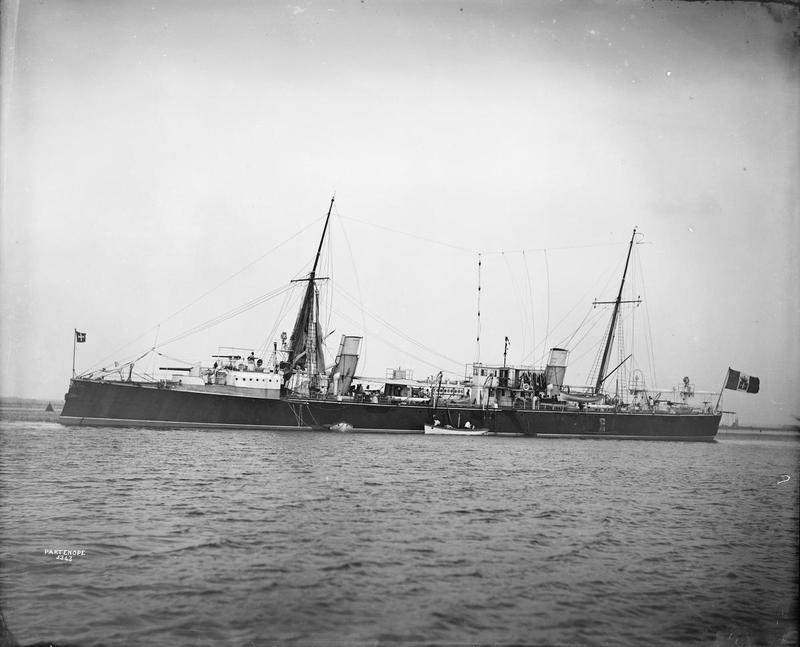
Partenope, the previous class of torpedo cruisers (eight ships, the last completed in December 1895)
These were the Tripoli (1886), Goito class (1888), Folgore classs (1886), and Partenope class (1889-94). Tripoli was designed by Benedetto Brin the precursor of the following classes. She was rearmed in 1904 and rebuilt, then re-armed a second time in 1910, with two 76mm, 57mm and 64mm guns, discarded in 1923. Goito was converted in 1897 and carried 60 mines. Montebello served as a training ship for mechanics in 1898, converted in 1903. The last three were modified in 1906-1909, thus having a new armament. Iride and Minerva were discarded in 1920 and 1921 but Partenope was sunk by UC67 on March 23, 1918.
Development of the Agordat class
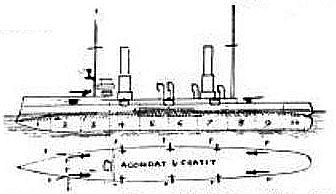 In this lineage, the Agordat class were at first classed as torpedo cruisers, but they became later protected cruisers. The design for the Agordat class, which was started in 1895, even before the completion of the last torpedo cruiser, Caprera (PARTENOPE CLASS) was prepared by Engineering Director Nabor Soliani. The admiralty staff had the wish to build a pair of fleet scouts.
In this lineage, the Agordat class were at first classed as torpedo cruisers, but they became later protected cruisers. The design for the Agordat class, which was started in 1895, even before the completion of the last torpedo cruiser, Caprera (PARTENOPE CLASS) was prepared by Engineering Director Nabor Soliani. The admiralty staff had the wish to build a pair of fleet scouts.
The filiation showed in their design, broadly similar to the previous Partenope class while beign significantly larger. In fact it was a 50% scaling up, with in addition a proper forecastle to manage better performances as a seaboat. Much hopes were placed of course in their powerplant, and after much debate, choice was made of eight Blechynden boilers to power two vertical tubes steam engines. Initial prospects called for 9,000 shp and 24 knots, to compare with the previous Partenope class, 4,000 ihp for 18 to 20 knots. There were discussions about protection, which had to be minimal as these ships were not intended to fight, as well as armament, which was purely defensive. They even got rid of the previous 4.7 in guns of the Partenope class.
Design of the class
The Agordat class, classified as “explorers” or scouts from 1914, and protected cruisers before, were just slightly larger than a destroyer of the time and roughly considered as light cruisers by default of a better classification. They were relatively unsuccessful units mainly to their steam engines while plagued by heavy compromises in protection and autonomy, not to speak of the ludicrously weak armament gor a “cruiser” of any kind. This seriously jeopardized her chances of survival in any combat.
She was de facto the lightest of all Italian cruisers at 1,300 tons but still largely above the average 500 tons of contemporary Italian destroyers. They were ultimately replaced by proper scouts at last, the excellent Quarto, with steam turbines and the proper performances for this role, followed by the Nino Bixio class.
Hull and general design
They had displacement around 50 percent greater while Soliani discarded their medium-caliber guns and choose instead an homogeneous battery of quick-firing 76-millimeter (3 in) guns derived from Vickers Guns made under licence by Ansaldo. The hull was similar in great lines than the previous Partenope class, but adopting a forecastle extended to the conning tower which made all the difference to carry out missions in all weather. They were constructed entirely from mild steel and wood in scarce quantities to reduce fire hazards in combat. Generally they were regarded as elegant ships, with their two tall funnels rakes and well spaced, and their two pole masts heavenly placed before the main bridge and behind the aft funnel.
The bridge placed in front of the foremast was an inheritance of the sailing navy, most cruisers keeping this caracteristic until the 1890s. It’s only after 1900 than most light cruisers had the formast placed behind the bridge, notably due to the needed proximity between the spotter and staff for fire corrections, carrying projectors but also signals and radio. In that guise, from two masts, it was reduced to just the forward one during refits after WWI, the aft mainmast being reduced to a short quarterdeck pole.
Measuring 87.6 meters (287 ft 5 in) between perpendiculars, 91.6 m (300 ft 6 in) overall they were 9.32 m (30 ft 7 in) wide, with a draft of 3.54 to 3.64 m when fully loaded (11 ft 7 in to 11 ft 11 in), for an overall displacement of 1,340 long tons (1,360 t) for Agordat, and 1,292 long tons (1,313 t) for Coatit. The ships were originally fitted with two pole masts, but the mainmast was removed in both vessels later in their careers. The crew ranged between 153 and 185 depending of the time. Both were painted in the classic peacetime scheme of black hull, white superstructure and canvas for funnels, air intakes and other structures. In 1914, they were both repainted in medium grey.
Armour protection layout
Not a strong point of the design: While the previous Partenope class had 1.6 in (40.6 mm) plating on their conning tower and main armored deck, on the Agordat class it was reduced to 3/4 inches at best for the armored deck or 11.43 mm, although it reached 20 mm on the slopes (0.79 in), acting a bit as internal semi-belts. This was only able to stop rifle fire and shrapnel, and it was only for the armored deck. There was a conning tower forward, persumably also with 0.79 in walls.
Powerplant
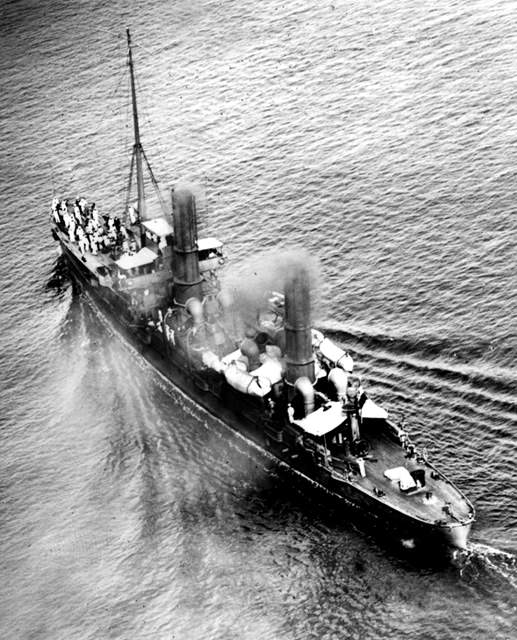
Agordat at full steam prior to WWI. This was one of the very earliest photos taken by an aircraft.
Probably the biggest point of contention as great hopes were placed on it. The final design speed only called for 22 knots, a bit light as scouts, but good for “protected” cruisers.
The steam engines were fed by eight Bleschynden boilers working at 15 standard atmospheres (1,500 kPa). The boilers were trunked into two widely-spaced funnels. Those of Agordat were slightly taller. They powered two alternative, three-stroke 8,000 hp engines, positioned halfway between the two boiler rooms. The steam engines in turn drove two bronze four-bladed propellers. There was a single rudder which was large enough for procuring some agility whitout beeding speed too much. They seemed a successful experiment at first, but the rapid progress made by armored cruisers, able to reach 20-21 knots led to the disapprearance of scouts, at least before 1911.
On paper, they eventually developed 8,129 ihp (trials figure) for a top speed of 22 knots, which was only obtained by Agordat with minimal weight and overheating and lake-like sea conditions. In realistic combat conditions, fully loaded, this was 20 knots. With the engines worn-out in WWI this went down more likely to 19. Coatit managed to reach the second design speed of 23 knots based on a superior output and same conditions, at 8,251 shp (6,062 to 6,126 kW respectively). As for their range, due to the ships being poor steamers, it only reached 300 nautical miles (560 km or 350 mi) at 10 knots, which was not even enough to patrol the Italian coast north to south in one go. This also made most destinations in the Mediterranean out of reach.
Armament
Although initially Solani envisioned the same 4.7 mm guns used on the previous Partenope, the choice was made for an homogeneous twelve 76 mm/40 (3 in Ansaldo) guns instead, for reasons of weight and stability (with a 4.7 in gun on top of the forecastle) and tactical reasons. This was completed two standard 450 mm torpedo tubes. This armament changed during post-WWI refits (see career).
Main
The main battery comprised twelve 76 mm L/40 guns on single mounts, with six placed in sponsons along the lower hull, aft of the forecastle, three each side, and two on deck aft. The other two were in casemates in the forecastle and two on deck. In early publications these seems far larger, owing the initial choice of 4.7 in guns.
These models derived from the Vickers gun, but using Fixed QF ammunitions. They used for the Breech single-motion screw system, were capable of 15 rounds per minute at 2,210 ft/s (670 m/s) and up to 11,750 yd (10,740 m) at 40° elevation. Some were landed and/or replaced during modernizations.
Torpedoes
Both cruisers came with two 450 mm (17.7 in) torpedo tubes. It is unclea if they were submarine, broadside or on deck, but likely the first option. They fired the standard Whitehead 1890 type.
Agordat – author’s illustration
⚙ specifications |
|
| Displacement | 1340t, 1292t. FL |
| Dimensions | 91.6 x 9.32 x 3.6 m ( x x feets) |
| Propulsion | 2 shafts TE, 8 boilers Blechynden, 8,300 hp. |
| Speed | 22 knots max (23 planned, 20 in 1915) |
| Range | 300 at 10 kts |
| Armament | 12 x 76 mm, 2 x 450 mm TTs. |
| Protection | Armored deck 16-19 mm (0.45-0.8 in), CT 0.8 in |
| Crew | 185 as built |
The Agordat class in action 1900-1923
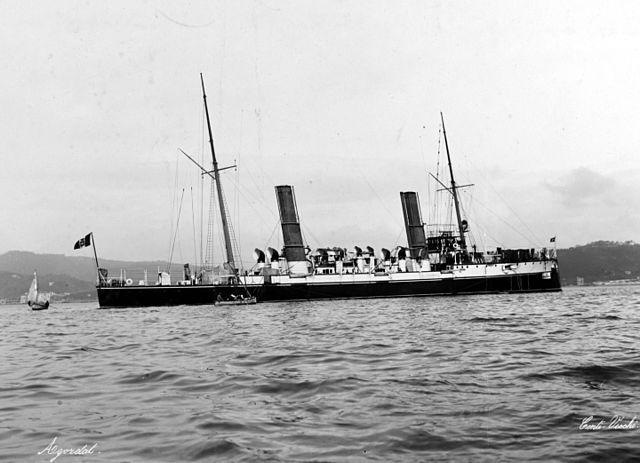
Agordat just entering service in the Bay of Naples in 1900
Both vessels were classified as “explorers” (Esploratori) on 4 June 1914. Their mediocre performabces soon changed these plans at the end of the war. Both ships served as reconnaissance vessels in 1914-18, which were not satisfactory because of their relatively low speed and range. The ships proved short-ranged and marginally faster than contemporary pre-dreadnought battleship designs such as the Regina Margherita class, limiting their utility as fleet scouts and prevented them to serve on foreign stations since they were unable to cruise long distances, so they could not be usable as gunboats, in addition to their armament, making for a poor deterrence anyway.
Agordat had to make up for the replacement of much older scouts of the 1860-70s and answer to this new type of unit widespread in Great Britain, fast and light to fulfill part of the tasks of the armored cruiser of the ‘exploratori’ in Italian sense, a modern interpretation of the “warning ships” used at Lissa. The armament was modified during construction, after envisioing 4.7 in guns, but quickly centered on a battery of small-caliber 76 mm having only on paper to combat torpedo boats, and expecting 22 kots being sufficient with a presence of larger units nearby.
 Agordat
Agordat
On 26 September 1900 under the command of frigate captain Emilio Prasca, the torpedo cruiser Agordat entered service in Naples.
Agordat, built in Castellammare, was laid down on 18 February 1897, launched on 11 October 1899, completed and commissioned with the Regia Marina on 26 September 1900. Sea trials by February-March 1901 so her reaching 22 knots, better than the 21 expected, and was partially in service in the years 1902–1904. Her unit comprised also eight battleships, six cruisers, and six destroyers, later reduced in 1905. She took part in the 1908 fleet maneuvers, as part of the “hostile force” simulating a landing on Sicily.
The Italo-Turkish War by September 1911 saw her assigned to the 2nd Division, 1st Squadron (RADM Ernesto Presbitero), separated from her sister. On 15 October, she was runited with her to escort the battleship Napoli, the cruisers Pisa, Amalfi, San Marco to escort a troop convoy to take Derna, which was done after failed negociations and a naval bombardment. She was meanwhile offshore to deter Ottoman counterattacks. Later with San Marco she raid Ottoman positions at Al-Kuwayfiya on 28 November, returning afterwards to Benghazi. In December 1911 stil with San Marco, the battleships Roma and Regina Margherita in Benghazi she prevented by gunfire Ottoman troops to close on the city.
Agordat also intercepted the French mail steamer SS Carthage on 16 January 1912 with an aircraft and pilot (Emile Duval) suspected to be Turkish mercenaries. She forced the steamer to go to Cagliari in Sardinia, on which the pilot and his plane were landed, before being authorized to proceed. The same happened with the French steamer SS Manouba, with fleeing Ottoman citizens aboard also brought to gunpoint to Cagliari. There was a mild diplomatic between the countries until the Ottomans were disembarked and the French pilot authorized to board another steamer, not for France but Tunis, still a protectorate. In April 1912 with Iride and other vessels she protected a 10,000 men troop convoy to Zuwarah (close to the Tunisian border).
By 1914, Agordat was assigned to the 2nd Division, 2nd Squadron comprising armored cruisers, supported by both and other scout cruisers. In May 1915, they were mobilized but after a few opertations in the Adriatic, the fleet was retired due to the submarine threat by Di Revel’s order, preferring blockading the southern end of the Adriatic with the Otranto Barrage. Although light, Agordat was too slow to perform attacks and saw little service but uneventful patrols.
In November 1918, she however took part in the International occupation of Constantinople, going through the Dardanelles, landing troops to occupy the city. In 1921, being reclassified as a gunboat she had four 76 mm guns retired and replace like her sister by two 120 mm (4.7 in) L/40 guns fore and aft, her TT removed, but on 4 January 1923 she was sold for BU.
 Coatit
Coatit
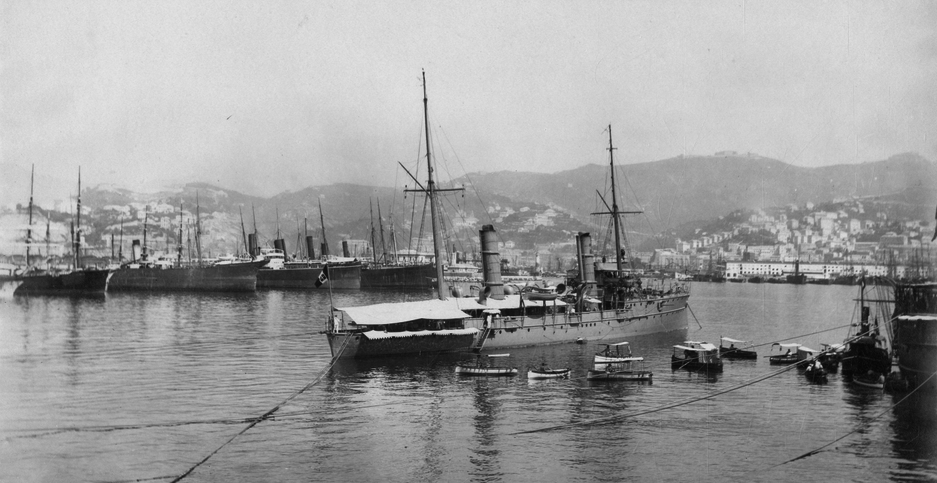
Coatit in Genoa, photo by Alfred Noack, already with her new grey wartime paint.
Coatit was laid down at Castellammare Di Stabia NyD like her sister on 8 April 1897, launched on 15 November 1899, completed and commissioned on 1 October 1900. As we saw ans like her sister way too “short-legged” as a scout, the admiralty stuck her with the main fleet in 1902–1904, ative yearly for seven months and with reduced crews the rest of the time. In 1904, she sailed for the Red Sea, staying in Eritrea as a gunboat with the old corvette Cristoforo Colombo, gunboat Volturno, aviso Galileo and “played” at being used to land enemy troops on Sicily in 1908 when back for Mediterranean fleet maneuvers.
Soon however, lk,eher sister she was prepared to take part in the Italo-Turkish War, and from September 1911 she was assigned to the 4th Division, 2nd Squadron (RADM Paolo Thaon di Revel). Her task was to secure the flanks of battleships and armored cruisers shelling Tripoli on 3–4 October. She later patrolled the area with the armored cruiser Varese and sixteen destroyers. No surprise attack came from the Ottoman Navy.
On 15 October, Coatit and Agordat with Napoli, Pisa, Amalfi, San Marco and three destroyers protected a coniy of troop transports landing at Derna. Negotiators were unsucessful and the port and city were pummeled. On 18 October the Ottomans withdrew and the port was captured. Both cruisers remained offshore in case of counterattacks for two weeks. On 3 October 1912, Coatit shelled the port of Kalkan, making light damage as expected but had more success against an exposed Ottoman infantry battalion spotted by aircraft, put it in flight and spending 200 rounds on these. The captain of the nearby French cruiser Bruix witnessed the attack and officially protested based on international law.
Coatit entered Constantinople during the First Balkan War, in November 1912, after the Italo-Turkish War was over, with Emanuele Filiberto, the French Victor Hugo and Léon Gambetta and two British cruisers, joined by Goeben, Rostislav and a Spanish vessel, together landing 3,000 men ashore to protect nationals. Later she stayed in the Sea of Marmara befoore joining Crete and going back home.
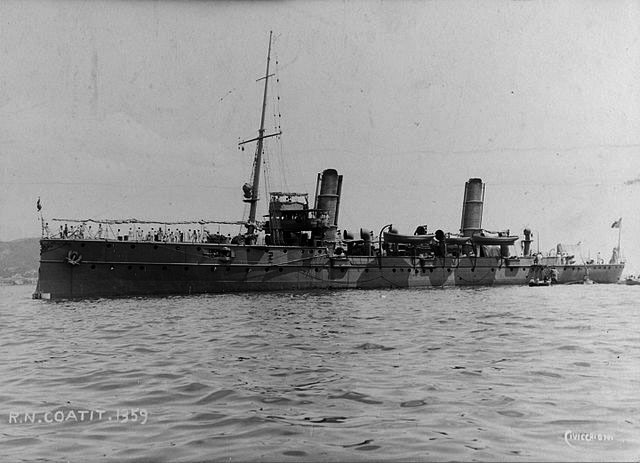
Coatit in 1916, note the mainmast has been removed.
In August 1914, Coatit was in the “special purpose” Division (2nd Squadron) with two Regina Margherita-class and two Ammiraglio di Saint Bon-class battleships, still acting as scout. With netrality gone by May 1915, Revel started the Otranto blockade and in that new context, Coatit rarely was at sea but to take part of patrols, without anything notable. In 1919 Coatit was converted into a minelaye, with eight 76 mm guns disposed of as her torpedo tubes. Instead two 120 mm (4.7 in) L/40 guns were installed fore and aft. Eventually she was placed in reserve and sold for BU on 11 June 1920.
Read More
Books
Beehler, William Henry (1913). The History of the Italian-Turkish War. USNI
Fraccaroli, Aldo (1979). Conway’s All the World’s Fighting Ships: 1860–1905. London: Conway Maritime Press.
Garbett, H., ed. (1902). “Naval Notes”. Journal of the Royal United Service Institution.
Leyland, John (1908). Brassey, Thomas A. (ed.). “Foreign Naval Manoeuvres”. J. Griffin & Co.
Marsh, C. C. (November 1899). “Notes on Ships and Torpedo Boats”. Notes on Naval Progress. General Information Series, No. XVIII
Willmott, H. P. (2009). The Last Century of Sea Power (Volume 1, From Port Arthur to Chanak, 1894–1922). Indiana University Press
Links
On en.difesaonline.it
https://www.battleships-cruisers.co.uk/italian_cruisers.htm
http://www.agenziabozzo.it/navi_da_guerra/c-navi%20da%20guerra/C-0377_RN_AGORDAT_1899_esploratore_corazzato_in_navigazione_di_prora_1912.htm
https://en.wikipedia.org/wiki/Agordat-class_cruiser
http://www.navypedia.org/ships/italy/it_dd_agordat.htm



 Latest Facebook Entry -
Latest Facebook Entry -  X(Tweeter) Naval Encyclopedia's deck archive
X(Tweeter) Naval Encyclopedia's deck archive Instagram (@navalencyc)
Instagram (@navalencyc)





 French Navy
French Navy Royal Navy
Royal Navy Russian Navy
Russian Navy Armada Espanola
Armada Espanola Austrian Navy
Austrian Navy K.u.K. Kriegsmarine
K.u.K. Kriegsmarine Dansk Marine
Dansk Marine Nautiko Hellenon
Nautiko Hellenon Koninklije Marine 1870
Koninklije Marine 1870 Marinha do Brasil
Marinha do Brasil Osmanlı Donanması
Osmanlı Donanması Marina Do Peru
Marina Do Peru Marinha do Portugal
Marinha do Portugal Regia Marina 1870
Regia Marina 1870 Nihhon Kaigun 1870
Nihhon Kaigun 1870 Preußische Marine 1870
Preußische Marine 1870 Russkiy Flot 1870
Russkiy Flot 1870 Svenska marinen
Svenska marinen Søværnet
Søværnet Union Navy
Union Navy Confederate Navy
Confederate Navy Armada de Argentina
Armada de Argentina Imperial Chinese Navy
Imperial Chinese Navy Marinha do Portugal
Marinha do Portugal Mexico
Mexico Kaiserliche Marine
Kaiserliche Marine 1898 US Navy
1898 US Navy Sovietskiy Flot
Sovietskiy Flot Royal Canadian Navy
Royal Canadian Navy Royal Australian Navy
Royal Australian Navy RNZN Fleet
RNZN Fleet Chinese Navy 1937
Chinese Navy 1937 Kriegsmarine
Kriegsmarine Chilean Navy
Chilean Navy Danish Navy
Danish Navy Finnish Navy
Finnish Navy Hellenic Navy
Hellenic Navy Polish Navy
Polish Navy Romanian Navy
Romanian Navy Turkish Navy
Turkish Navy Royal Yugoslav Navy
Royal Yugoslav Navy Royal Thai Navy
Royal Thai Navy Minor Navies
Minor Navies Albania
Albania Austria
Austria Belgium
Belgium Columbia
Columbia Costa Rica
Costa Rica Cuba
Cuba Czechoslovakia
Czechoslovakia Dominican Republic
Dominican Republic Haiti
Haiti Hungary
Hungary Honduras
Honduras Estonia
Estonia Iceland
Iceland Eire
Eire Equador
Equador Iran
Iran Iraq
Iraq Latvia
Latvia Liberia
Liberia Lithuania
Lithuania Mandchukuo
Mandchukuo Morocco
Morocco Nicaragua
Nicaragua Persia
Persia San Salvador
San Salvador Sarawak
Sarawak Uruguay
Uruguay Venezuela
Venezuela Zanzibar
Zanzibar Warsaw Pact Navies
Warsaw Pact Navies Bulgaria
Bulgaria Hungary
Hungary

 Bundesmarine
Bundesmarine Dutch Navy
Dutch Navy Hellenic Navy
Hellenic Navy Marina Militare
Marina Militare Yugoslav Navy
Yugoslav Navy Chinese Navy
Chinese Navy Indian Navy
Indian Navy Indonesian Navy
Indonesian Navy JMSDF
JMSDF North Korean Navy
North Korean Navy Pakistani Navy
Pakistani Navy Philippines Navy
Philippines Navy ROKN
ROKN Rep. of Singapore Navy
Rep. of Singapore Navy Taiwanese Navy
Taiwanese Navy IDF Navy
IDF Navy Saudi Navy
Saudi Navy Royal New Zealand Navy
Royal New Zealand Navy Egyptian Navy
Egyptian Navy South African Navy
South African Navy






























 Ukrainian Navy
Ukrainian Navy dbodesign
dbodesign